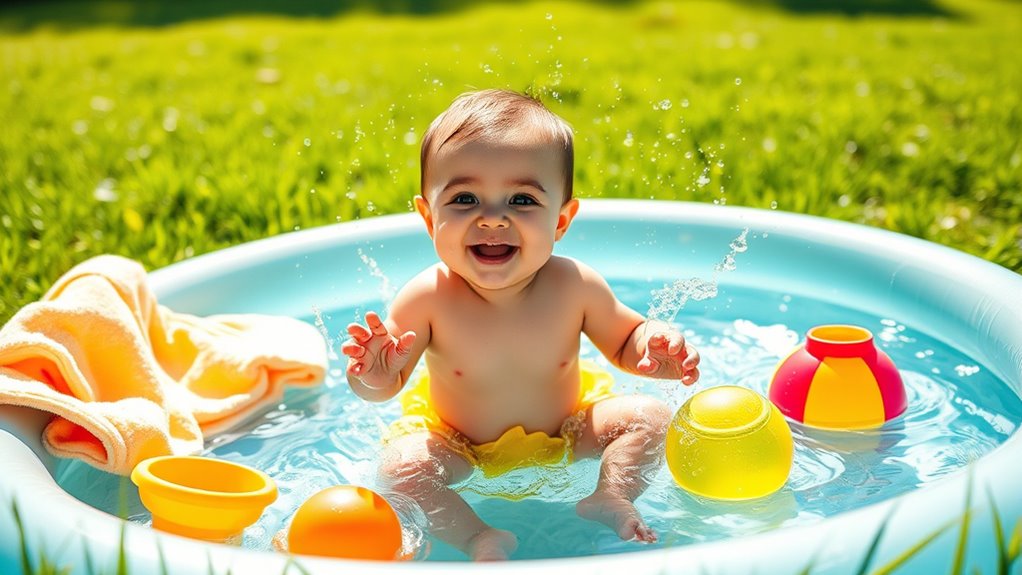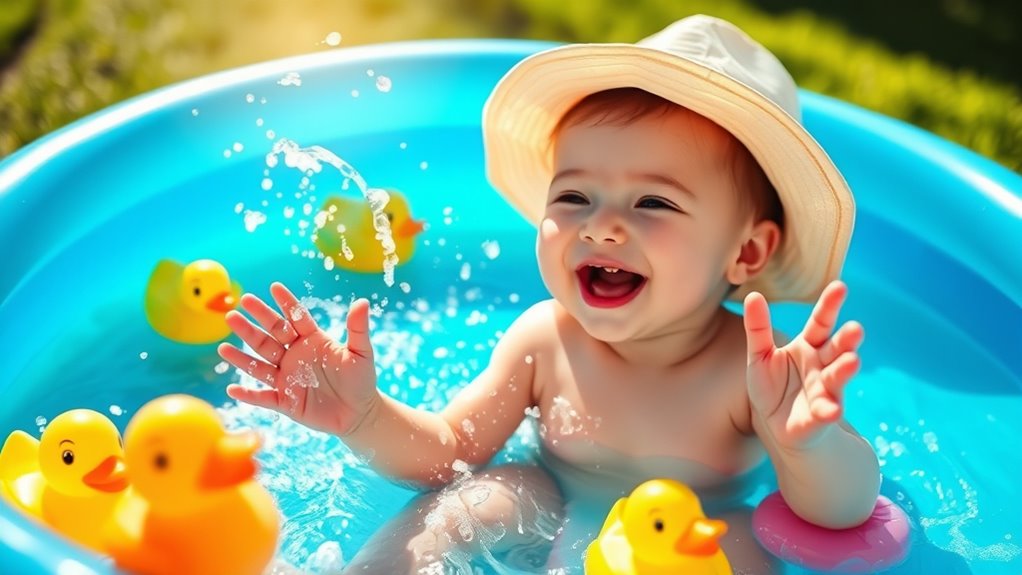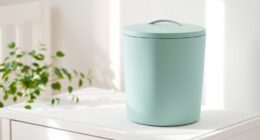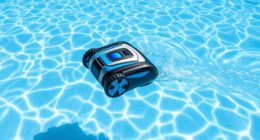Water play can be a fun and safe activity for your baby. Start with a water table or a shallow container, ensuring constant supervision. Include exciting toys like squirt toys and rubber ducks to spark their curiosity. Try engaging them in activities like pouring and splashing, which enhance motor skills and cognitive development. Remember to always check water temperature and use non-slip mats for safety. Discover even more engaging ideas to make water play a regular joy!
Key Takeaways
- Use shallow water in a safe environment, ensuring constant supervision to prevent accidents during playtime.
- Incorporate sensory bins with water and safe materials like rice or sand for varied exploration.
- Engage babies with floating and sinking toys to promote cognitive development through experimentation.
- Use non-slip mats around the play area to minimize slipping hazards during water play.
- Keep water at a comfortable temperature to protect your baby’s sensitive skin during activities.

Water play activities for babies not only provide endless fun but also promote essential development skills. When you introduce your little one to water play, you’re opening the door to a world of sensory exploration. As babies splash, pour, and manipulate water, they engage with different textures and temperatures, enhancing their sensory development. This type of play is suitable for babies around six months old, depending on their individual growth, and it can be done safely with proper supervision.
To get started, you don’t need much equipment. A simple water table, sink, or large container filled with water will do the trick. As your baby splashes, they’re not just having a good time; they’re also honing their motor skills. Pouring water from one container to another helps develop fine motor coordination, while the act of splashing encourages hand-eye coordination and dexterity. These physical skills are crucial for their overall development.
Water play isn’t just about physical benefits; it also supports cognitive growth. When babies experiment with water, they’re learning to explore and solve problems—like figuring out which toys float or sink. This exploration fosters curiosity and creativity. Moreover, engaging in water play can be a social activity. If you have siblings or friends over, babies can interact with each other, promoting social skills and emotional growth in a relaxed environment.
Although water play is beneficial, safety should always be your top priority. Constant supervision is essential to ensure your baby stays safe while having fun. Make sure the water is shallow enough for them to sit or stand comfortably, and always maintain a comfortable temperature to avoid shocking their sensitive skin. Non-slip mats around the play area can also help prevent slipping accidents.
You can incorporate various activities into your water play sessions. Babies love splashing and pouring, but you can also create sensory bins with water and other materials like rice or sand for added texture. Using water tables can make the experience even more interactive, allowing for endless exploration with different toys, such as squirt toys and rubber ducks. Bath time can also become an exciting part of their daily routine with the inclusion of fun toys.
Incorporating water play into your baby’s routine not only provides joy but also supports their development in multiple ways. So gather your supplies and enjoy the splashes—both in the water and in your little one’s growth!
Frequently Asked Questions
What Age Is Appropriate for Introducing Water Play to Babies?
You can start introducing water play to babies as early as newborns, but it’s best to wait until they’re around 6 months old for more interactive experiences.
At this age, they can enjoy gentle splashing and the sensation of water, promoting sensory exploration. Always supervise them closely, ensuring a safe environment.
As they grow, you can gradually incorporate more complex water activities, enhancing their cognitive and motor skills while keeping safety a top priority.
How Can I Ensure Water Play Is Safe for My Baby?
To ensure water play is safe for your baby, always supervise them closely.
Check the water temperature to make sure it’s just right, and keep the area free of hazards.
Use non-slip mats and soft toys to prevent accidents.
Have a first aid kit handy, and maintain good hygiene to avoid infections.
What Types of Toys Are Best for Water Play?
Did you know that engaging in water play can enhance a child’s cognitive and motor skills by 20%?
For optimal water play, you’ll want to choose toys that promote creativity and learning.
Consider bath blocks for stacking, water droppers for color mixing, or foam shapes for sensory exploration.
Outdoor options like water tables and diving toys can also encourage imaginative play.
These toys not only entertain but also support your child’s development in a fun way.
How Long Should Water Play Sessions Last for Infants?
Water play sessions for infants should last between 10 to 30 minutes, depending on their age and attention span.
For younger infants, shorter sessions are better to keep them engaged without overwhelming them. Keeping it brief enhances focus and prevents fussiness.
Make sure to mix activities to maintain their interest, and always supervise closely to ensure safety.
Can Water Play Help With My Baby’s Development?
Yes, water play can significantly aid in your baby’s development.
It enhances gross and fine motor skills as your little one scoops, pours, and reaches. You’ll notice improved hand-eye coordination and balance too.
Water activities stimulate cognitive skills by exploring concepts like buoyancy, while the sensory experience engages their senses, promoting emotional regulation.
Plus, it encourages social interaction and creativity, helping them build confidence and essential social skills through shared play.
Conclusion
In conclusion, engaging your baby in water play not only fosters sensory exploration but also supports crucial developmental milestones. Studies suggest that early exposure to water activities can enhance motor skills and promote cognitive growth. By ensuring safety through supervision and age-appropriate toys, you create a fun and enriching environment. So, grab those bath toys and let your little one splash away—it’s not just play; it’s a step toward their overall development!









